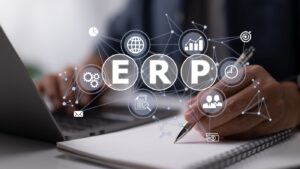- Jason Flye
- Reading Time: 4 minutes

As enterprise clients increasingly explore Gen AI to drive large-scale transformations, the technology is beginning to redefine how SI services are delivered, helping to streamline execution, accelerate timelines, and create new avenues for operational efficiency.
However, this shift also introduces new challenges. Without clear transparency into how Gen AI will be integrated into delivery models and commercial structures, customers may face unpredictable costs, unclear accountability, and delivery risks. The lofty promises of Gen AI must be balanced with a demand for clarity and consistency to ensure these innovations translate into sustainable value.
Staying in control of large-scale transformations has never been more critical. As we’ve discussed in our insights on reclaiming value midstream in ERP programs and on rethinking transformation strategy in an AI-first world, organizations must balance course correction with forward-looking strategies that account for AI’s growing influence on delivery models and business outcomes.
This blog explores how SIs are using Gen AI, the transparency gaps customers must address, the commercial guardrails needed to protect value, and the risk and compliance measures critical for responsible adoption.
Exposing Transparency in Gen AI Use
SIs supporting ERP implementation projects are increasingly adapting their delivery approach to incorporate the use of Generative and Agentic AI. While many SIs may speak to their planned utilization at a high level, it is critical that customers understand the impact that AI use may have at a detailed level.
We see a growing trend that many SIs are open to reflecting Gen AI-driven productivity improvements directly within the staffing model, showcasing anticipated efficiency gains in staffing estimates and resource allocations. In addition, a growing number of SIs have begun to include AI agents as discrete line items in their staffing models, signaling a move toward the operationalization of AI tools within delivery teams.
There is also a clear willingness among vendors to continue to assess opportunities to inject AI during your program, particularly as new Gen AI use cases emerge in response to rapid advancements in the technology.
As SIs expose their planned utilization of AI, we are often seeing that these vendors are positioning Gen AI functionality as “investments” made on behalf of the client. While the AI tools do provide benefit to the customer, a key question to pose is whether these tools are really all that different than SI-specific accelerators that are used to speed up delivery. In addition, these so-called investments improve the SI’s internal productivity and reduce delivery effort, functioning as cost-saving levers for the vendor.
The SIs are leveraging customer inexperience with Gen AI to reduce the level of scrutiny. This only reinforces the need for clients to rigorously assess the role of Gen AI in their programs. Key areas to probe include:
- What Gen AI tools are being proposed?
- How will they be applied?
- What specific outcomes do they enable and for whom?
Leaving these questions unanswered runs the risk of accepting an ambiguous value proposition.
Creating Commercial Guardrails for Gen AI Use
While understanding how your SI plans to use Generative AI is critical, it is equally important to ensure that they are contractually committed to its planned use. This includes expecting your SI to take accountability towards how AI is leveraged and to share any upside that stems from overachievement.
Once customers have understood and established the AI baseline of planned utilization, it is important that they protect themselves from the under-use (AI tools do not deliver the outcomes expected) and over-use (AI tools deliver outcomes above and beyond expected).
We have started to see SIs show willingness to agree to Gen AI “gainshare” models in large scale transformations. This model establishes a value-sharing structure where if the use of Gen AI were to deliver efficiency gains beyond the initially forecasted productivity improvements, any resulting cost underruns would be equitably allocated between both the vendor and the client.
With fixed fee models, however, the SIs have shown more reluctance to adopt explicit AI gainshare mechanisms, likely due to the tighter margins and lower flexibility inherent in such pricing structures. Establishing an AI gainshare model is critical, as without it, customers may find they are paying for resource hours/effort that are not required within the Program.
In the inverse, it is important that customers receive commitments from their chosen SI to absorb any additional costs that are incurred due to AI tools not delivering the productivity that is expected. All SIs are optimistic about the outcomes that their AI agents and tools can achieve, but it is important that customers avoid Change Orders that may stem from overconfidence in these tools.
Lastly, on risk and compliance, the SIs are showing transparency by proactively outlining their security controls, policies, and procedures to mitigate AI-related liability, reinforcing their commitment to responsible AI deployment.
The Bottom Line
To ensure value and minimize exposure, customers must stay a step ahead of vendors from the earliest stages of the RFP process. It’s no longer a question of if a vendor will include Gen AI capabilities in their proposal, but how those capabilities will be positioned, priced, and ultimately delivered. Customers must proactively define their expectations and request clarity on how Gen AI will be operationalized in their programs.
As Gen AI adoption accelerates, customers must remain vigilant in interrogating both the upside and downside of these capabilities. Taking a proactive and structured approach early in the vendor evaluation process will help ensure that AI does not become a black box, either in cost or risk.
